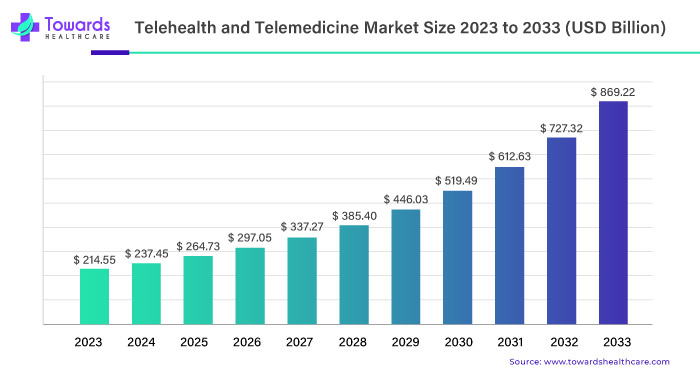
Telemedicine is revolutionizing the healthcare industry, offering numerous benefits that are making healthcare more accessible, efficient, and affordable. By leveraging technology, telemedicine enables patients to consult with healthcare professionals remotely, improving the overall experience for both patients and providers. With the market for telehealth and telemedicine experiencing rapid growth, it’s clear that this transformation is just beginning.
Market Growth and Future Projections
The telehealth and telemedicine market has surged in recent years, reaching a staggering USD 214.55 billion in 2023. The sector is expected to continue its impressive growth, with projections estimating a market size of USD 869.22 billion by 2033. This represents a healthy compound annual growth rate (CAGR) of 15.5% from 2023 to 2033. As technology continues to advance, these solutions are becoming an integral part of healthcare delivery worldwide, with software and services driving the market forward, accounting for 71% of the market share in 2023.

The cloud-based delivery model has emerged as a dominant force, holding 67% of the market share in 2023. This model allows for easy access to healthcare services from anywhere, making it even more appealing for patients and providers alike. Telemedicine platforms are also at the forefront of this technological shift, capturing 45% of the market share in 2023. These platforms facilitate virtual consultations, enabling patients to receive timely and convenient care without leaving their homes.
Improved Access to Care
One of the most significant benefits of telemedicine is the improved access it provides to healthcare. Around 93% of telemedicine solutions have enhanced patients’ access to care, a major advantage for individuals in remote areas or those with mobility constraints. Telemedicine breaks down geographical barriers, offering patients the opportunity to consult with medical professionals no matter where they are, ensuring timely care despite time or location constraints.
Increased Efficiency
Telemedicine is not only improving access but also making healthcare more efficient. Around 77% of telemedicine solutions contribute to better time management for both patients and healthcare providers. Virtual consultations eliminate the need for travel and long waiting times, allowing doctors to see more patients throughout the day. This efficiency is a crucial factor in meeting the growing demand for healthcare services globally.
Cost Reduction
Another key advantage of telemedicine is its potential for cost reduction. 71% of telemedicine solutions help lower healthcare costs by minimizing the need for in-person visits, transportation, and time off work. This is especially important for both patients and healthcare providers, as it makes healthcare more affordable while simultaneously reducing the burden on healthcare infrastructure.
Enhanced Communication Between Doctors and Patients
Effective communication is a cornerstone of quality healthcare, and telemedicine is improving this aspect as well. 71% of telemedicine solutions have enhanced communication between doctors and patients. With features like video consultations, secure messaging, and image sharing, virtual visits allow for more interactive and efficient exchanges. This improved communication helps ensure better diagnoses and more personalized treatment plans.
Strengthening Doctor-Patient Relationships
Telemedicine also plays a vital role in strengthening relationships between doctors and patients. About 60% of telemedicine solutions contribute to building stronger doctor-patient connections. The convenience of virtual visits allows for more frequent check-ins, fostering a sense of continuity and trust. These strengthened relationships result in improved care and better health outcomes for patients.
Chronic Disease Management: A Key Focus
A major area of focus within telemedicine is chronic disease management, which accounts for 30% of telemedicine’s market share in 2023. Telemedicine has become a crucial tool in managing long-term conditions like diabetes, hypertension, and heart disease. By enabling regular check-ups and remote monitoring, telemedicine allows for better management of these conditions, improving quality of life and reducing hospital readmissions.
Regional Growth: Asia Pacific Leading the Charge
The telemedicine market is witnessing remarkable regional growth, particularly in the Asia Pacific region. This region is expected to experience an exceptional 27.5% CAGR, driven by the growing demand for healthcare services, improvements in digital infrastructure, and rising healthcare needs across developing nations. As telemedicine adoption increases in this region, it will play a key role in reshaping healthcare delivery globally.



